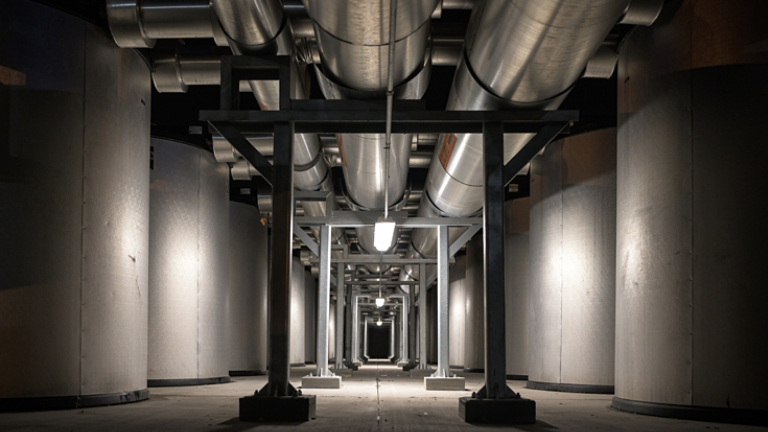What Is Energy Storage?
Energy storage is defined as the process of capturing energy produced at one time for later use. It's commonly used with batteries of all sizes, but there are other kinds of energy storage.
Types of Energy Storage
There are five categories of storage for using energy later, but only two of them are typically applied to commercial HVAC systems. We'll list all five and then go into more detail below with the ones that are most relevant to our clients and partners.
- Electrochemical: These storage devices are the ones most people are familiar with — batteries! Energy is stored in chemical form and released as electricity when needed.
- Mechanical: This includes pumping water uphill and releasing it to generate electricity as needed, flywheel technology in which a spinning rotor stores kinetic energy, and compressed air storage.
- Chemical: Hydrogen fuel cells and biomass are examples of chemical storage.
- Electromagnetic: Two examples include capacitors storing energy, creating an electric field, and a coil carrying current, creating a magnetic field.
- Thermal: Three ways to store thermal energy include sensible heat storage, latent heat storage, and thermochemical storage. Sensible heat storage can be done with materials like water and rocks. Latent heat storage requires the changing of the phase of a material, like ice melting into water. Thermochemical storage can happen by creating a chemical reaction that stores heat and later reversing it to release that stored energy.
Of these five types of energy storage, thermal and electrochemical are most commonly used with HVAC systems.
How Is Battery Energy Storage Used in HVAC Systems?
Battery energy storage systems (BESS) are used in conjunction with HVAC systems to power equipment like chillers and pumps, especially when integrated with renewable energy sources. Let's look at how BESS can work with HVAC:
- Energy Storage: BESS stores electrical energy in rechargeable batteries, often lithium-ion.
- Charging: The BESS is charged by converting AC grid or DC solar power (or other renewable) into a battery-friendly DC voltage.
- Inverter: BESS uses a bi-directional inverter (or Power Conversion System - PCS) to convert DC power from the batteries into AC power for use.
- Discharging: When power is needed, the stored DC power is converted back to AC and supplied to the HVAC equipment (chillers, pumps, etc.) or back to the grid.
- HVAC Integration:
- BESS can power HVAC systems, reducing reliance on the grid during peak demand.
- Somewhat ironically, HVAC systems are crucial for maintaining the correct temperature range for BESS operation. Batteries generate heat during charging and discharging, and temperature significantly affects their performance and lifespan. HVAC systems remove this heat to ensure safe operation, prevent overheating, and maintain operational temperature and humidity.
- HVAC systems in BESS containers often have intelligent control mechanisms that use temperature sensors to monitor conditions and adjust cooling capacity to maintain the recommended operating temperature.
- An energy management system (EMS) controls and schedules BESS activity and optimizes performance.
Sources of Stored Energy
- A BESS is often used to store excess energy generated by renewable sources like solar and wind power. This stored energy can then be used when renewable generation is low.
- The electrical grid can charge a BESS during off-peak hours when electricity costs less. This energy is then used during peak hours to reduce demand and lower energy costs.
- In some cases, BESS can be charged by generators, including diesel generators, although this is less common as the goal is usually to reduce reliance on fossil fuels.
Key Considerations for HVAC in BESS
- Maintaining a consistent temperature (e.g., around 20°C/68°F with a fluctuation range of ±3°C/5.4°F) is crucial for optimal battery performance and longevity.
- Adequate airflow across the battery modules is essential for heat dissipation.
- Managing humidity levels is also important to prevent corrosion and other damage to the BESS.
- HVAC systems for BESS containers need to be meticulously designed, considering factors like temperature sensor placement, cooling air volume, and environmental challenges like dust and sand.
How Is Thermal Energy Storage Used in HVAC Systems?
Thermal Energy Storage (TES) is the most common type of energy storage used in HVAC systems. TES involves storing thermal energy for later use for heating or cooling. Common storage media include water, ice, and phase change materials (PCMs).
- Ice Storage: Ice is made and stored during off-peak hours and then melted during peak hours to provide cooling.
- Water Storage: Water is heated or chilled and stored in tanks for later use.
- Phase Change Materials: These materials absorb and release heat during a phase change (e.g., melting or freezing), providing efficient energy storage. Examples include phase-change salts.
The Process for Thermal Energy Storage Systems and HVAC
- Charging: During off-peak hours or when excess energy is available, the TES system stores thermal energy. This can involve cooling storage (chilling water or freezing water into ice) or heating storage (heating water, phase change materials, or other suitable media).
- Storage: The thermal energy is stored in an insulated medium. Common storage methods include chilled water, ice, and PCM storage. In chilled water storage, water is chilled and stored in large, insulated tanks. For ice storage, water is frozen into ice, which stores a large amount of cooling energy per unit volume. If using PCMs, they absorb and release heat as they change phase (e.g., solid to liquid or liquid to gas) at a specific temperature.
- Discharging (Energy Use): When heating or cooling is needed, the stored thermal energy is released. In a cooling release, chilled fluid or melted ice is circulated through the building's cooling system to provide air conditioning. In a heating release, stored hot fluid or heat from PCMs is used to heat the building.
Thermal energy storage in commercial buildings is integrated with chillers, heat pumps, and other HVAC equipment.
- Chillers: TES can reduce the size of chillers, as they can operate during off-peak hours to charge the storage system.
- Heat Pumps: TES can store heat generated by heat pumps for later use, improving their efficiency.
- Building Management Systems (BMS): A BMS controls the TES system, optimizing charging and discharging based on energy demand, weather conditions, emissions and energy prices.
Sources of Energy for Thermal Energy Storage in HVAC
- The electricity grid is used to power chillers, heat pumps, or electric resistance heaters that charge the TES system. Often, this charging occurs during off-peak hours when electricity rates are lower.
- Renewable energy sources , like solar, can heat water or other fluids, which are then stored in the TES system for later use in heating or cooling.
- Waste heat from industrial processes, power plants, or other sources can be captured and stored in the TES system.
- Combined heat and power (CHP) systems generate electricity and heat simultaneously. The excess heat can be stored in a TES system for later use.
- Natural gas can be used to power boilers or other heating equipment that charges the TES system.
Energy storage efficiency is the measure of how effectively a system can store and later release energy. It's usually measured in round-trip efficiency (RTE). A higher RTE means less energy is lost during storage and retrieval. Thermal energy storage tends to rate well. For example, thermochemical storage can have efficiency approaching 100%.
Energy Storage Resources
Choosing the Right Energy Storage System
On-site energy storage can help your organization reduce its reliance on the local utility's power grid, which can be especially useful if that grid is not dependable. It can also support your sustainability goals and cut down on operating expenses. But how do you know which energy storage system is the best one for your facility? Talk to the experts here at Trane. They can assess energy usage, the property's available space, and your organization's goals and financial capabilities to determine the right system for you.




